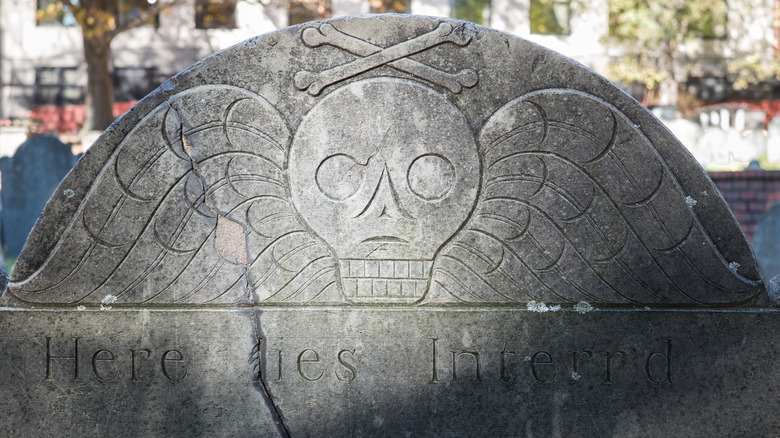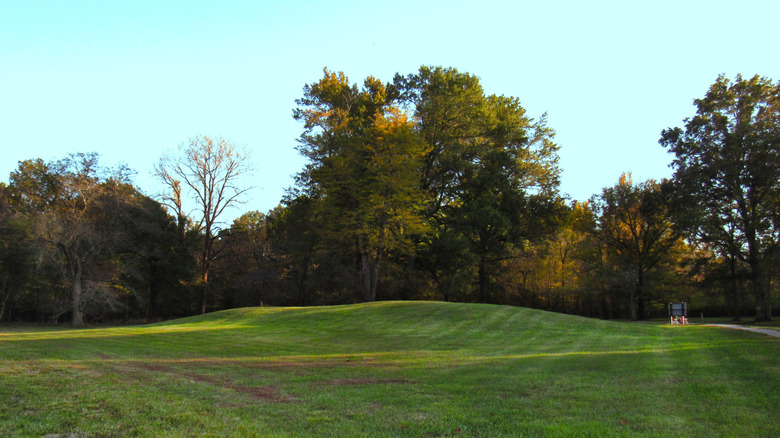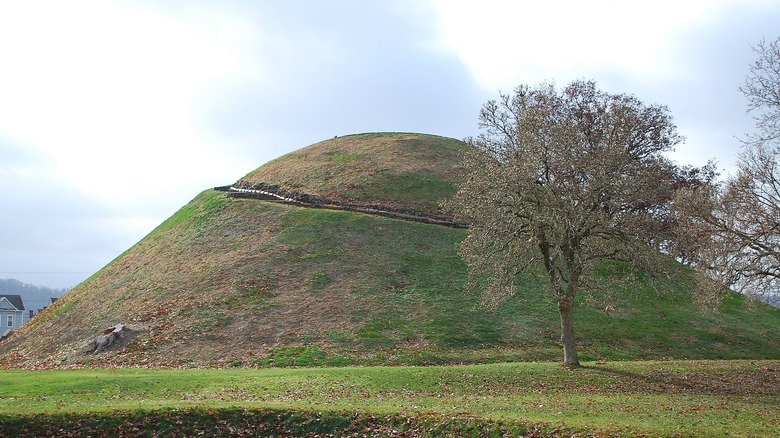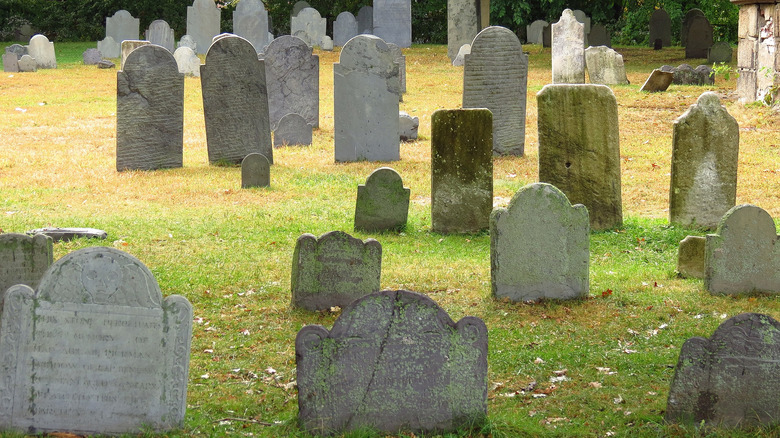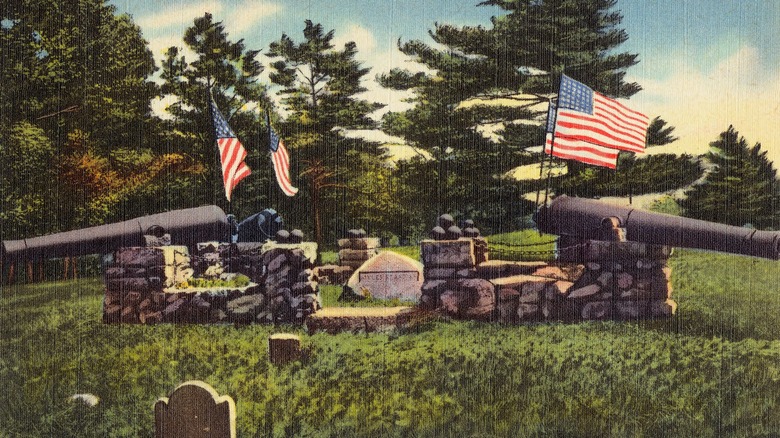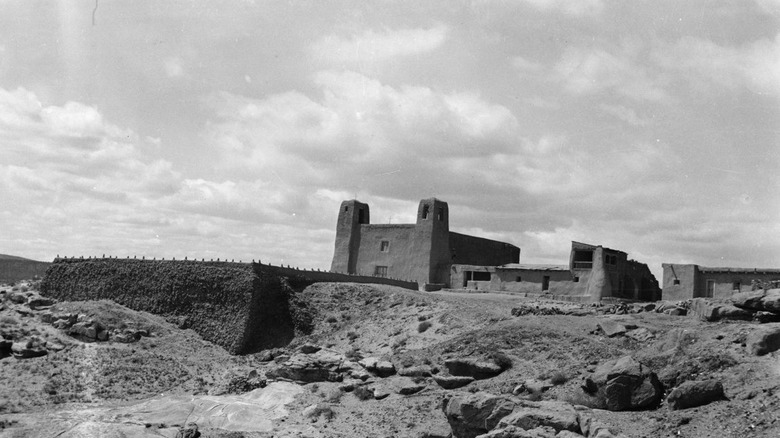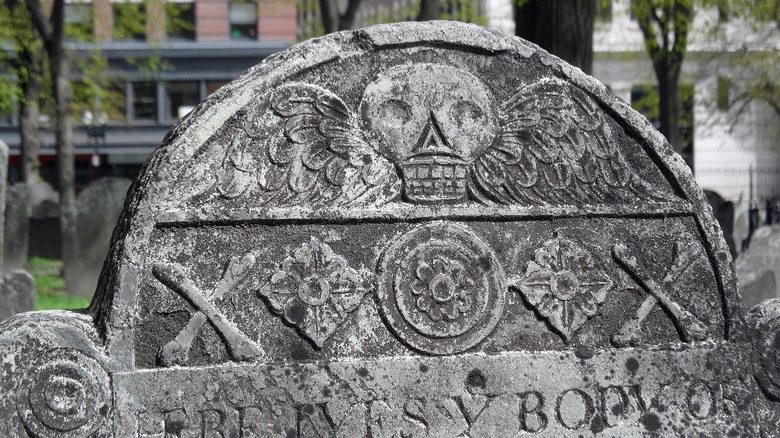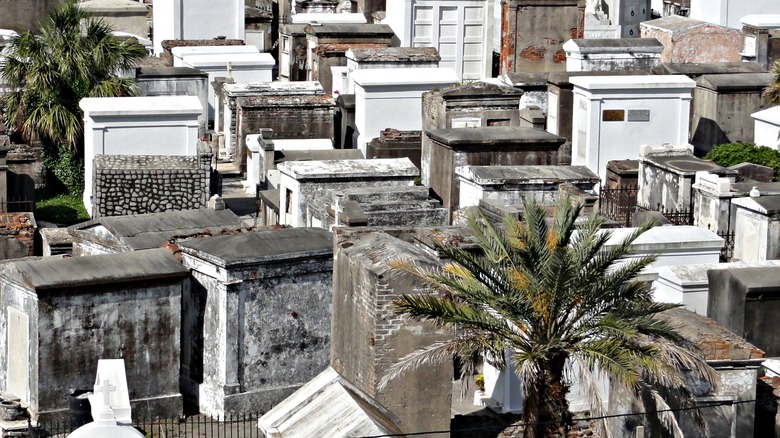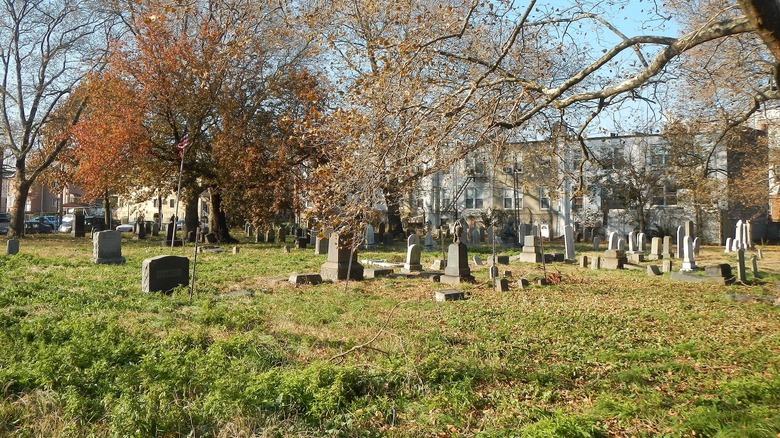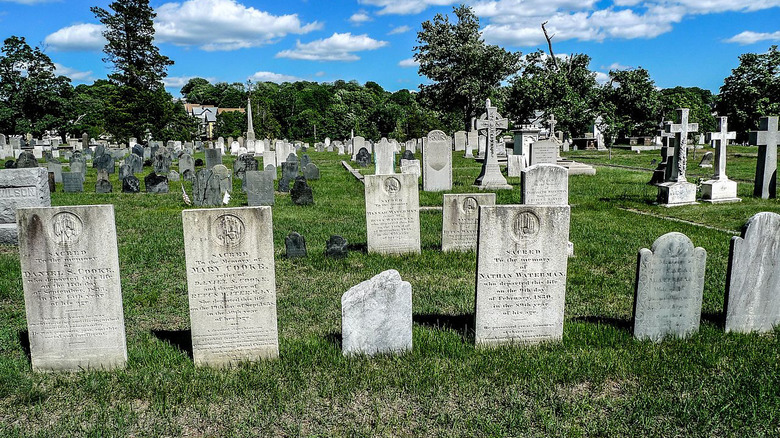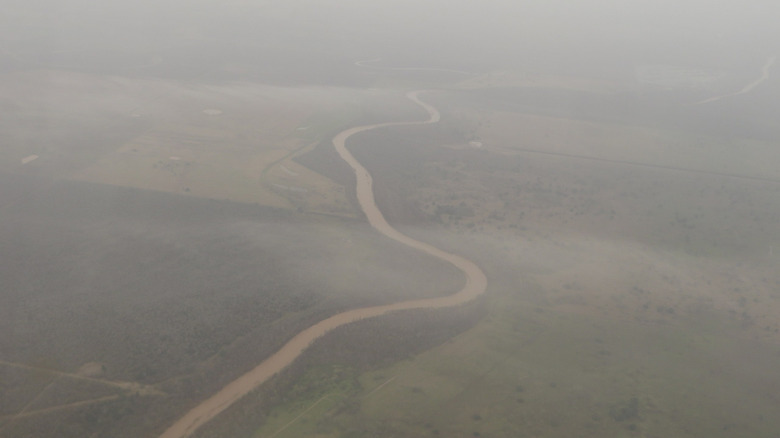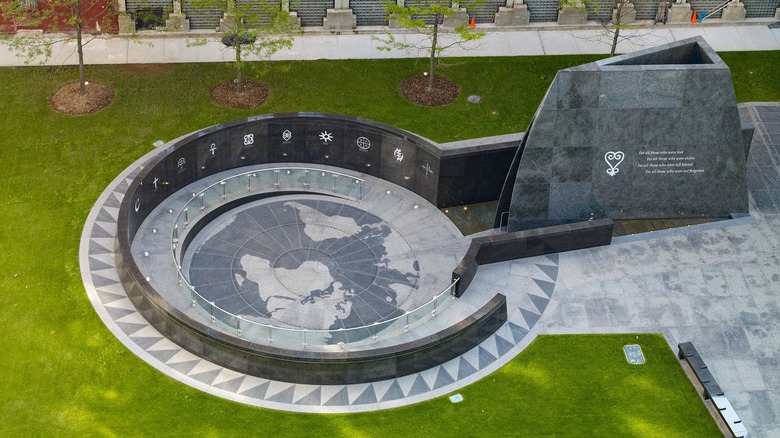The Oldest Cemeteries In America
Cemeteries may at first seem like little more than creepy set dressing for a horror movie or some late night teenage misadventures. Yet a little investigation makes it clear that these sites are rich with history. It's not just that they are the final home of some of America's most prominent citizens (though quite a few are); they also speak to the wider story of all Americans, from some of the poorest and most neglected citizens to its mythologized shining stars. As the Texas Historical Commission points out, burial grounds of all sorts are a treasure trove of information about the past, telling us how people lived, where they settled, what they believed, and what was truly important to them and their loved ones at the end of their lives.
But what are some of the oldest cemeteries in America? A few date back to some of the earliest European colonizers who set foot in the region in the 17th century. Yet more are even older and speak to the long history of the continent's indigenous peoples. Many are also beautiful and peaceful places to visit, so long as you do so respectfully (looking at you, partying teens). All of them contain fascinating information about America's past, so long as you care to take a look. Read on for a peek into some of the oldest burying grounds in the nation's history.
Cahokia
Today, Cahokia is best known as a state historic site in Collinsville, Illinois. But, centuries ago, it was nothing less than one of the largest cities in North America. According to the World History Encyclopedia, Cahokia is actually a 19th-century designation for the place, given that we don't know what the original inhabitants called their sprawling, complex settlement. We do know that Cahokia was a pretty big deal. The city was at its height from 600 to 1350 CE, with more than 15,000 people living in its environs at the peak of its population. Cahokia boasted a complex layout with residential neighborhoods, sports fields, marketplaces, an agricultural sector, and a series of mounds. Those last structures were apparently used for religious ceremonies and definitely contained burials.
Of those burial mounds, the largest and most complete one is today called Mound 72, as per the University of Illinois. Archaeologists working since 1967 have uncovered the remains of 270 people within this one mound. Some of the entombed rest in mass graves, with at least one group burial showing signs of violence. These unfortunates were laid to rest right before the site was effectively abandoned in the 13th century, hinting at a bloody regional conflict.
Other burials show that the dead were buried with rich grave goods and upon luxe platforms of cedar. These high-status inhumations included women as well as men, indicating that the people of Cahokia may have held relatively egalitarian views on gender (via CBS News).
Grave Creek Mound
With a name like Grave Creek Mound, it may not be surprising to learn that this indigenous burial mound in West Virginia does, in fact, contain human burials. What is shocking is the age of this burial ground — from about 250 to 150 BCE — and the sheer amount of effort it took to construct it. According to the West Virginia Department of Arts, Culture, and History, the Adena people near what's now Moundsville, West Virginia, would have had to move more than 57,000 tons of soil to raise Grave Creek Mound. The main mound was also surrounded by similar smaller structures, but agriculture and greed (in the form of looters) destroyed many of these.
We at least have evidence that Grave Creek Mound was the site of prestigious burials. Some of the dead there were buried with valuable grave goods, including metal jewelry, smoking pipes, and tools made from flint stone. As the West Virginia Department of Arts, Culture, and History notes, Grave Creek Mound was also multi-use, in that it contains multiple layers of burials. Some of the burials uncovered in 1838 by local landowners included thousands of shell or ivory beads, valuable sea shells, and copper bracelets. However, the efforts of these 19th-century amateur archaeologists almost certainly destroyed evidence that would have revealed more about the life of the Adena mound builders (via "Moundsville's Mammoth Mound").
Charter Street Cemetery
Also known as Old Burying Point, this cemetery in Salem, Massachusetts, is one of the oldest European-style burying grounds in the United States. According to Charter Street Cemetery, the first mention of Old Burying Point came about in 1637, though the records imply that it was already an established burial place by that time.
The oldest known gravestone comes to us from 1673 and belongs to Doraty Cromall, according to the City of Salem. Earlier markers were made out of wood and simply didn't survive centuries of New England weather, making it all but impossible to establish exactly when the first person was laid in the earth at this graveyard.
Given that this is a cemetery in Salem, a settlement popularly known as "Witch City," you may think that some of the victims of the infamous Salem Witch Trials are buried here. While the accused were tried nearby, their remains would not have such a comfortable resting spot. Smithsonian Magazine reports that those who were executed for supposedly practicing witchcraft were sometimes buried in secret by family or else in an unmarked mass grave near the hanging place (via the City of Salem). They certainly weren't given a proper Christian burial next to the likes of witch trial judge John Hathorne (whose remains still lie in Charter Street Cemetery). You can at least visit the Salem Witch Trials Memorial right next to the cemetery, and now a new memorial has been erected where the condemned were hanged.
Myles Standish Burial Ground
Often billed as the oldest "maintained" cemetery in the United States, the Myles Standish Burial Ground in Duxbury, Massachusetts, may not strictly be the oldest in the nation, but it's certainly up there. New England Today reports that it was established in 1638 and is host to the mortal remains of many notable passengers on the Mayflower, the English ship that brought colonists to the area in the 17th century.
Though some of the earliest markers are no more, the ones that do remain are characteristic of the Puritan outlook on life and death. These include imagery such as death's heads and somewhat less creepy winged angels. Puritans were especially fond of memento mori, or reminders of death's imminence, including skulls, hourglasses, and coffins, as well as inscriptions urging passers-by to consider their own mortality (via the City of Boston).
And, yes, military commander Myles Standish is amongst the dead here. As per Atlas Obscura, Standish died and was buried near Duxbury in 1656. By the 19th century, people wanted to recover his remains from the long-neglected burial ground. The people of Duxbury went on a digging spree and, once they determined that they had probably found Standish, put a memorial on top of his bones in 1893. In 1931, the body was exhumed yet again so it could be placed in a suitably fancy coffin and sealed in a concrete vault, where it remains today.
San Estévan del Rey churchyard
The churchyard of San Estévan del Rey near New Mexico's Acoma Pueblo rivals any old Puritan graveyard. The mission was founded in 1629, according to the National Park Service.
Franciscan missionaries established the mission in an attempt to help Spain maintain power over the people of the nearby Acoma Pueblo, which had sat atop the mesa for many generations. The mission represented the wider colonial enterprise that sought to replace indigenous beliefs and ways of life with European ones, including a Catholic system that required burial. That forced assimilation was interrupted by the Pueblo Revolt of 1680. At Acoma, indigenous people held the mesa until 1699 (via NPS).
According to Cemetery Travel, this cemetery is the result of backbreaking labor. The area was originally bare rock, so the soil used to inter the dead had to be carried up on foot. Currently, the cemetery consists of five levels contained within walls that reach almost 50 feet high. After so many centuries, space is at a premium. The current level of graves is meant to be the last and is reserved for elders and full-time residents of the pueblo. And though the cemetery and church represent the colonial effort to destroy indigenous belief, Acoman cultural touches are still visible. These include sculpted faces within the cemetery wall meant to represent guardians, while one section of the wall contains a hole that is said to allow spirits to leave for the afterlife.
Granary Burying Ground
In the middle of crowded, busy Boston is one place that's full of stillness, at least as far as its permanent residents are concerned: the Granary Burying Ground. Though this cemetery gained its name in 1737 (after a grain storage building was moved nearby), burials at the site actually began much earlier, starting in 1660. According to the City of Boston, the last individuals to join the group were buried there in 1880. Over the 120 years that the dead of Boston were placed here, about 5,000 people were interred in the Granary Burying Ground. However, time has not been kind to all of the memorials, as only an estimated 2,345 markers remain today.
Missing gravestones aren't the only thing that has complicated the history of this cemetery. The City of Boston further notes that 19th-century Bostonians were unhappy with the awkward hodgepodge of the burials. So, they set about rearranging the headstones into neat, visually appealing rows that were easier to maintain. They also added the walkways now trod by many visitors to the burying ground.
Given the history of Boston and its residents, there are quite a few big names for those tourists to seek out. These include revolutionary figures like Samuel Adams, John Hancock, and Paul Revere, as well as the victims of the 1770 Boston Massacre. That last group includes Crispus Attucks, a Black and indigenous sailor buried alongside the four other men killed in the incident (via National Park Service).
St. Louis Cemetery No. 1
As the oldest standing cemetery in New Orleans, St. Louis Cemetery No. 1 already has plenty of history at its back. It's also visually striking, at least to visitors who may not be used to its closely-packed aboveground tombs. According to New Orleans Catholic Cemeteries, St. Louis Cemetery No. 1 was established in 1789, after city officials worried that earlier, now defunct cemeteries couldn't hold all the dead after a series of fires and an epidemic ravaged the city. Initially, burials were likely in the ground, but an 1803 ruling ordered that all new burials be in aboveground structures. Otherwise, floods in the low-lying city could result in gruesome and unsanitary exhumations.
It's all but impossible to discuss St. Louis Cemetery No. 1 without mentioning one of its most famous inhabitants: Marie Laveau. Pinning down anything more than the broad outline of her life is difficult, but we do know that Marie Laveau was born in New Orleans around 1801, as per Atlas Obscura. As the mixed-race daughter of a Creole mother and white father, she ostensibly worked as a hairstylist but was actually renowned for her work as a voodoo priestess. Even after her death in 1881, many believed that she still carried great power and would write Xs on the tomb to curry favor with Laveau's spirit. That practice, which has nothing to do with voodoo, is now strongly discouraged and can earn a stubborn graffiti artist a serious fine.
Old Gravesend Cemetery
In a bustling metropolis like New York City, it may be easy to assume that the oldest pieces of history are routinely paved over and forgotten. Yet quite a few of the city's cemeteries date back to the 17th century, when it was little more than tiny settlements populated by Dutch settlers (via BBC).
One of the oldest is in Brooklyn, though at the time of its establishment, Brooklyn was technically its own settlement. According to the City of New York, Old Gravesend Cemetery was first mentioned in a 1658 will. Given that the document mentions an already-standing graveyard, it's possible that the burial grounds were established not long after Gravesend's founding in 1643.
The cemetery likely contains the remains of Lady Deborah Moody, the founder of Gravesend and the first woman to establish a settlement in the region (via Brooklyn Eagle). It contains 379 stones, many of which are part of an ongoing restoration project, though none point towards Moody's last resting place. That's a shame, as Moody was a unique figure in early American history. Deemed a religious rebel for her belief in adult baptism and her attempts to convert others, Moody was excommunicated from the Puritan church and forced to leave her home in Massachusetts. The well-off Moody settled near New Amsterdam, where she carefully laid out Gravesend, becoming one of the first known city planners of the colonial era (via The National Society of Colonial Dames).
North Burial Ground
Small as its state may be, the North Burial Ground of Providence, Rhode Island, is kind of a big deal. As per the North Burial Ground Project, this cemetery has been around since 1700, when town officials set aside about 45 acres of land in north Providence for interments. The first burial, of Samuel Whipple, took place in 1711 and probably involved just a simple shroud for one of the most prominent citizens of the settlement (via the City of Providence).
The establishment of a burial ground was a necessary step away from the old practice of family graveyards scattered across the countryside, which took up valuable real estate in a growing, bustling settlement. The drive to make burial all the more efficient even pushed Providence residents to exhume many of their relatives in 1785 and re-inter them in the North Burial Ground. Since then, it's undergone a myriad of changes, including more grave relocations, a rollercoaster budget, and a prominent monument that went missing after the city took it down following a car accident in the 1980s. Most surprising of all for such an old cemetery is the fact that it's still accepting new burials, with an estimated 200 per year (via North Burial Ground Project).
Some of the notable residents include pioneering professor and mountain climber Annie Smith Peck, poet and noted early goth Sarah Helen Whitman, and Kady Brownell, who's said to have fought in the American Civil War alongside her husband (via North Burial Ground).
Ernest Witte site
When it comes to cemeteries, one of the oldest in the nation isn't in New England or any of the other former colonies. Instead, it's far south and west, in what's now the state of Texas. According to the Texas State Historical Association, the burial ground known to modern researchers as the Ernest Witte site was first used around 2,700 BCE. It was used for the next 4,000 years, with the last burials taking place around 1500 CE. It's named after young Ernest Witte, who found ancient human remains while digging with his brother near the Brazos River in the 1930s. He didn't bother to tell archeologists about this discovery until well into his adulthood, when he reached out to the Texas Archeological Survey in 1974.
An estimated 238 people are buried at the Ernest Witte site, with about 61 individuals in the oldest area of the excavation. Some of these prehistoric people were buried with grave goods, including bone tools and a stone point. More recent burials uncovered a wider array of objects, such as stone and shell jewelry, animal skulls, and stone knives. Some also appeared to have died violent deaths, perhaps because of territorial struggles in the area. Though there obviously aren't written records for this time period, the TSHA notes that the existence of the burial ground is good evidence of a growing population that felt the need to stake its claim to the land, in part by burying the dead there.
African Burial Ground
Sometimes history remains hidden for centuries, only to be uncovered generations later. Such was the case for what is now called the African Burial Ground. As per the National Park Service, this cemetery was the final resting place for both enslaved and free Black people in New York City, some of whom likely were taken from their birthplaces across the Atlantic in Africa. Though it remained active from the 1630s until 1795, the burial ground was soon forgotten until it was uncovered again in 1991. That year, construction for an office tower uncovered some of the graves located along Broadway. All told, it's estimated that more than 15,000 people are buried in the earliest known African cemetery in the United States.
The first Africans began to arrive in Manhattan in the early 17th century, with a free Black man known as Juan Rodrigues in 1613, followed by enslaved Africans in 1625, according to the National Park Service. Eventually, Black residents were highly segregated regardless of their free or enslaved status. Even death saw them relegated to their own cemetery, which eventually grew to more than six acres.
In 2003, the 419 individuals whose remains were excavated were reinterred in the African Burial Ground Memorial Site after they had been transferred to a facility in Washington, D.C., a decade earlier. They were placed in hand-carved coffins, each stacked in crypts now covered by a series of seven burial mounds (via National Park Service).
